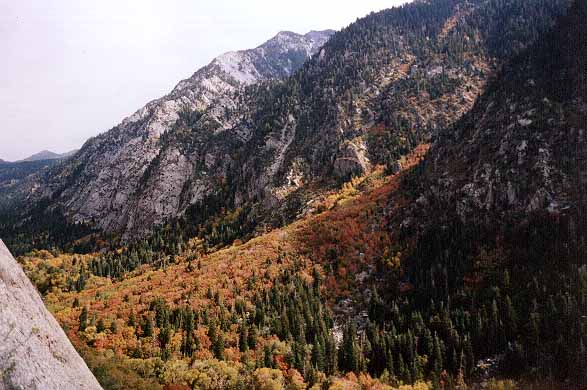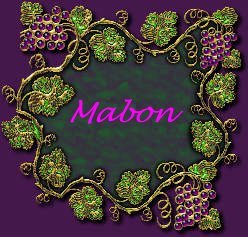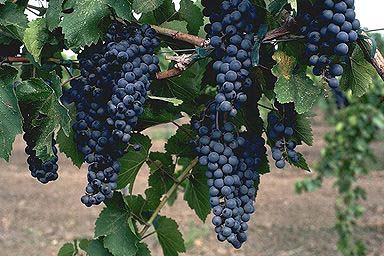
Autumn is the season when the sun declines from the meridian and the nights begin to lengthen, towards the Winter Solstice. The Celtic Wiccan alignment for this season is southwest, west, northwest. The correspondences for the season are fire of water (summer showers in late August, especially thunderstorms) water, (fog, rain, evening mist) and earth of water (morning and evening frost, occasional snow in some areas, mud and swamplands) The time of day is sunset, symbol of the slow death of the year. The Autumn Quarter is thought of as beginning on the first moon after Lammas, which is the last Summer Sabbat, and closing at Samhain, the last Solar Festival of Autumn.
The colour correspondences are greys, soft blues, grey-green, deep gold and orange, brown, and deep purple, wine and black. These colours are represented in turning leaves, ripening squashes and pumpkins, dying vegetation, and ripe grapes, as wine is made at this time of year. Foods of the season include all that is harvested from trees, vines, and below the ground, fish, wild game, pork and nuts. It is a season of storing and preserving, so at this time we honor the makers of wine, cheese, preserved fruits, vegetables and grain, weavers, leatherworkers, butchers, and hunters, especially those who hunt the deer, who gives his life for the land at this time.
The witch's life begins to turn inward, as we see our bodies and minds imitate the slowing and gathering process which the Earth is performing. It is a time for divination, dreamwork, preserving and gathering herbs, blessing sacred waters (make moonwater on the full moon closest to Samhain to use in scrying throughout the year) gathering and creating medicines for winter, making wine for ritual, and sorting and assembling the contents of one's Book of Lights and Shadows. It is an intimate, silent, personal time for communion with spirit guides and totems, as well as personal deities.
In our modern lives, it is often difficult to remember that we still have an alignment with the land. On a mundane level, our lives also honor the Autumn Quarter and the effect of the Season on our activities and inner lives. For example, in America and the Western European countries, the dates for commencement of school are in the Autumn because of the many years when able-bodied children could not be spared to the classroom until the harvest was got in. This is also the reason for long summer vacations, and a week or so off school around the Spring Equinox, which coincides with planting time far longer than with Easter celebrations. Autumn energies for urban pagans often include the fixing up, cleaning up and painting up of house and yard to batten things down for winter. Many of us make preserves and can foods. Some of us hunt. Rural people are involved in shearing, butchering and mulching fields to lie fallow. City-dwellers are "Winterizing" their cars, changing summer for winter clothing, putting up the storm windows, having the furnace checked, fixing and cleaning the flues and setting in a supply of firewood.
Here
is a poem by e.e cummings that has a feel of Autumn, and means more than
it says:
all nearness pauses, while a star can grow all distance breathes a final dream of bells; perfectly outlined against an afterglow are all amazing the and peaceful hills (and where not here but neither's blue most both) and history immeasurably is wealthier by a single sweet day's death: as not imagined secrecies comprise goldenly huge whole the upfloating moon. Time's a strange fellow; more he gives than takes (and he takes all) nor any marvel finds quite disappearance but some keener makes losing, gaining ---love! if a world ends more than all worlds begin to(see?)begin
The letter for the Hazel Tree in the Tree Alphabet is "C", the letter Coll. The nut of the Hazel is brown (Cron ) and unobtrusive, as is the nature of true wisdom not to call attention to itself. The letter "C" also is the initial letter of the word "Crane", a bird which is a symbol of wisdom in Chinese mythology as well as that of the Celts. The Irish word is "Corr"...like the "core" of an apple, the center of the matter. The pattern of flying cranes against the sky is said to have been the inspiration for the strokes of the Ogham and the letters of the alphabet...and words ( letters) are the repositories of wisdom. The Celtic Shaman carried his magickal totems in the Crane-bag, and the Crane is sacred to the ninefold Goddess of wisdom because of the nine steps he takes before taking off in flight.
At the Hazel Moon, Witches concentrate on the lore and wisdom of their elders, on nurturing and expanding their own inner wisdom, and on studying the wisest ways to deal with the situations of their own lives. The letter "C" is a talisman for this process...to be wise, we must "see." Making I Ching rods from hazel twigs, dreamcatchers wound on hazel branches, and the eating of, dreaming upon, or carrying of hazelnuts are various ways the acquirement of wisdom are symbolically encouraged.

In a grove of aspen trees, it is never silent. The leaves tremble in the slightest breeze, giving the tree the nickname "Quaking Aspen". It is said that if one is silent in a grove of aspens, one will hear the whispered voices of Fey Folk.
At the time of the Autumn Equinox, the Aspen tree's leaves are turning a brilliant gold. The colour is so intense that in the dim greyness of Autumn skies, the light within a grove of aspen trees is often brighter than that outside. The round gold leaves look like coins, and legends of those who go home from beneath the Hollow Hills with their pockets filled with faery gold always state that in the light of day this gold becomes a handful of round golden leaves. This golden colour reminiscent of bright summer sunshine makes this tree the perfect symbol for the station of the Autumn Equinox. Just as the days and nights pause in their motion for a moment of balance, and light and darkness are equal, so do the turning leaves of the Aspen, reflecting the Sun's brilliance, serve to remind us that at the depth of darkness, the next station of the Winter Solstice, we can be assured of the rebirth of Light.
The Aspen has a special significance to Witches, as all the aspen trees in a single grove grow from one source...in reality, all we see above the ground shares a root system and is in reality one tree. This makes the Aspen a perfect natural exemplar of clan or family, as well as the traditions of the ancestors and the law and courage and faith of the ancient peoples on whom our knowledge of Craft is built, and from whom sprung our lore as well as our lives.
The Celtic Tree Alphabet assigns the letter "Eadha" or "E" to the aspen tree. "Ela", the Whistling Swan, readies her brood for flight from winter's cold at this time. And the sound of the long "e" is an exhalation of breath, very like the sound symbolic of the dying year.


The Autumn Equinox is called "Mabon" in the Celtic Tradition, after the Young God Mabon or Maponus, whose name means "son" or "Son of the Mother" In the Mabinogion, the Welsh mythic cycle, he is mentioned in the Tale of Culluch and Olwen. He is spoken of as "having been stolen from between his Mother and the wall when only three nights old." The search for him is part of a larger quest, that of Arthur and his companions to win Olwen, the daughter of Yspaddadden Pencawr, for Culluch.
Mabon is the archetype of the Initiator, and will be the Hunter on Arthur's quest. For us then, he is an archetype of the Hidden Deity, the God within, whose discovery begins our own Quest, the hunt for the hidden self-knowledge that defines the Initiate. It is significant for us to know that Mabon, since stolen as an infant, was able to gain all his knowledge and power from within, alone, and was his own teacher, as are all true seekers. His festival coincides with the Autumn Equinox to emphasize the need for inner and outer balance, and to remind us that all harvests begin with the balance of life and death. The beasts who assist in questing for him represent the forces of the five senses within us and the alignments each of us bears to the representative energies of the five directions~~Mind, Will, Feelings, Body and Spirit.
The Autumn Equinox is the "Witches Thanksgiving", a high harvest festival. The grain has been brought in, and the grapes are being harvested. The day and night are of equal length, reminding us of the balance of nature. As we see the year draw to a close, we look at the cycles of our own lives which are ending. This festival is a time when many Witches celebrate rituals of ending, cleansing or destroying tools which are no longer useful, doing cuttings from situations or relationships which have ended, burning or burying charms or talismanic objects which have served their purpose. The symbolism is that ending things does not cause all life to end, but merely recognizes a point of stasis, as the equal night and day of the Equinox, after which there will be a change and a renewal. This is also a time of thanksgiving for achievement and for the bounties of the earth and the "harvests" of our lives.

grape jewel graphics courtesy of
![]()
![]()
![]()
![]()
![]()


Wine is a symbol of resurrection and rebirth, and the energy of the Vine month is for intoxication, exhilaration, conviviality and friendship. This season is the "Witch's Thanksgiving"..."feast, sing, dance, make music and love all in My name...For mine is the ecstasy of spirit and mine also is joy upon the Earth." The season is the Gateway to Winter, so there is a beginning here of the collection and preservation of the wines and oils and sweetmeats which will be used in the festivals of deep Winter, particularly the Solstice.
There is also a consciousness of our links with other worlds, and shamanistic visions, obtained by wine and spirits, are common at this time. This Moon also marks the beginning of the season of conviviality, which stems from the ancient custom of "Wintering-In" or drawing the Clans together not only to celebrate the harvest festival, but for warmth, company and protection as the hard bitter winter set in.


Ivy represents life arising from death, as it is the nature of the plant to grow over ruins and destroyed places, bringing them vibrant green life. Yet paradoxically ivy also represents death from life, as a strong ivy plant will kill and destroy any other plant or structure it is rooted in. So the symbol of Ivy for the witch is the journey to the center of the Self, and the rebirth engendered by the death of what is discovered there.
The Ivy month leads into the season of Samhain, where the dead are encountered and new life is engendered. "I give knowledge of the Spirit eternal, and beyond death I bring peace and freedom, and reunion with those who have gone before. It is a season of laying to rest, letting go, harvesting and preserving, and planting for the future.



The
Harvest Gift--A Song for Mabon
(Morwyn
ní Bhrighide...©1996)
Flame on leaf and sunlight in our eyes Somehow fall is happening beneath the summer skies... Gold and brown the fields and crisp the air... Shadows of the summer's heat No longer waver there... We touch the cool of daybreak and the breeze is fresh and chill And a voice within comes wide awake where everything is still, And says; "The year is turning The Autumn fires are burning But even now new life is to be found Beneath the ground!" In the Fall are harvests gathered In a heap 'neath cloudy skies But there still are seeds of Springtime Shining deep within our Eyes... Dance the Wheel of Mabon, The balance of the year, Never future looked so bright, Never past so dear; Weave the thread of living, Hand to hand the chain; The harvest comes, The Crone is near, The Wheel turns round again.SAMHAIN
The
festival of Samhain (SOWin or sahVEEN) meaning "Summer's End" takes place
October 31. For the ancients, this was the day when the gates between the
worlds stood open, and travel was unrestricted. The year's dead were honored
with a "dumb supper", a meal where places were laid for them and they were
assumed to be present. The lives and feats of kings, warriors and heroes
were chanted by the bards that the history of the people might be preserved.
Our custom of jack o'lanterns comes from the great honor the Celts placed upon the head. Heads of enemies were taken to denote mastery, and the head of a king or hero might be preserved as an oracle, or made into a cup or lantern to symbolically infuse followers with courage or light. The Celtic tale of Bran the Blessed and the Wondrous Head is the most famous tale which is based upon this custom.
The first of November was the New Year to the Celts, and so Samhain was the time when all things died which were not to be carried over. No crops left in the fields could be harvested, nor flocks slaughtered; debts were forgiven or paid; divorces were made final; all matters of court or legal business were concluded before sunset on the 31st.
For us, then, Samhain becomes a time to release all that is still undone in this Wheel. For a follower of the Old Ways, the cycles of Nature are as important as ever they were, and Samhain is a time when things WILL die, end, release, whether or not we are aware of it. Much of the "winter depression" and unrest people feel in the dark time of the year is a simple failure to recognize and follow the patterns of their lives as they follow Nature.
So this is a time to forgive others and yourself, release things that bind you or are still undone, lay to rest old habits which restrict you, cut loose from people or situations that are in any way "dead" or bring "death" to you. This is also the best time of the year for divination, since the veils between the worlds are thin and the Folk are awake.
The Celtic lunar calendar ascribes this season to Reed, the tree of the hunter and housebinder. Reeds were used to thatch houses, and to make the arrows with which winter's meat was hunted. The symbol for us is the preparation which will make all secure for body and soul to withstand the chill and darkness of winter.
Following the month of reed comes the month of elder, the tree of ancient wisdom. This tree calls to us to look to ancestral memory, both cultural and individual, to remember the ancient truths which will preserve our lives through the winter until the Sun returns.


The reed in bundles thatched the home, and the sharing of the cutting, binding and thatching of bundles of reeds as a couple was a token of marriage among the early Celts and Saxons. Indeed, our words "Wife" and "Husband" arise from the reed-winding necessary to make a home, as the woman wove with her hands the plaits which were twisted to repel cold, wet and insects, and the man took the ropes of willow withy to bind the plaits into thick mats and pillars for floor, wall, door and roof. And so the "wyfen" ( weaver) and the "husbund" ( house-binder) joined the works of their hands to create a home in which to begin their lives together.
Participating in every aspect
of the communal life, reeds were used to create the shed and batten for
the loom of the cloth-weaver, the stirring-stick and roasting skewer for
the cook-pot, and the first musical instrument. The bundled reed is the
symbol of Winter security, as these were the walls and rooves of the shelters
of the earliest people. Coming ripe as they do in the fall, the growth
of the reeds was the signal as to how many, how warm and how spacious would
be the clan houses that year.